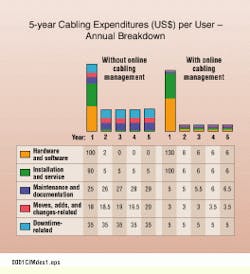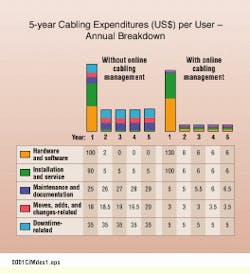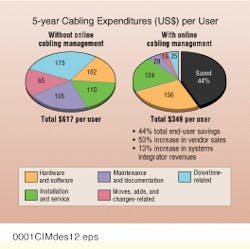This approach allows a redistribution of project revenues that has already paid off for some.
Nitzan Cafif
RIT Technologies
The cabling industry has been experiencing a quiet revolution the past three years. More and more corporate clients are demanding real-time intelligence in their cabling systems, and cabling vendors are hurrying to meet these demands.
A real-time cabling-management system provides real-time information on the status of connections at the wiring closet, reports all connectivity changes to the network-management station in real time, and guides the system administrator in planning and implementing wiring changes.
End users are making demands for improved control and management of their cabling systems for several reasons. Competition among cable vendors is tough, with a total market estimate of only 3.5% growth (3% U.S. market and 4% global market) for 1999, according to the 1999 market forecast of Data Communications (December 1998 issue). With the advent of cabling standards and their market acceptance, brand-name cabling no longer provides the edge for a cabling vendor to win a contract with the end user. And as all vendors now give similar warranty terms, this once-effective sales feature now offers little advantage. So vendors are looking for other competitive means to increase their sales.
Most importantly, corporations are actively investigating ways to reduce their network-infrastructure expenditures. Corporate users have a prime example of excellent network control and management, established when network systems standardized on simple network-management protocol (SNMP)-based management. This innovation proved to the world the value and necessity of computerized network control and maintenance. The enormous resulting savings in time, resources, and money have made SNMP management a de-facto requirement in every network.
Each corporation`s logical next move is to expand intelligent centralized management throughout the infrastructure. Offline cabling-management applications simply fall short of the capabilities required. Corporate end users are realizing that the goal of seriously reducing huge maintenance expenses and the associated downtime costs can be achieved only by building real-time management into their cabling systems for complete control and management.
Win-win situation
Three distinct groups--the cabling vendor, the systems integrator, and the corporate end user--are involved in the real-time cabling-management revolution, each with its own interests and each needing the other two. The bottom line is cost savings and improved revenue for each group. Remember the network-management scenario, where there was slow but steady acceptance in the industry of this innovation. Each interest group benefited under the establishment of management and control.
Innovative developments generally energized the market: What was once acceptable is no longer good enough. The innovations, while often more expensive upfront, are generally designed to ensure savings in the long run, which in today`s fast-paced world can be as early as one to two years.
Cabling with real-time cabling management, pioneered by RIT Technologies (Tel Aviv, Israel) and accepted as an industry requirement by industry giant Lucent Technologies (Murray Hill, NJ) is one such innovation.
Case for cabling-system vendors
The cabling industry reached a plateau in development and maturity in the early 1990s. As cabling infrastructures became standardized, vendors lost their competitive edge in a market that was experiencing little growth.
Today, integration between the cabling system and management tools will differentiate one vendor`s system from other, non-managed cabling solutions. Developing new, intelligent cabling, which requires more technological skill and training than developing typical systems found today, will increase the vendors` costs. However, revenues generated from the scanning devices, software applications, and added value built into the cabling system will offset these costs. Today, there are few if any additional revenues once installation is completed, but in a managed system, software upgrades and new software modules will bring additional revenues over the short and long term.
While these vendor revenues translate into initial higher costs to the corporate client, cabling vendors easily can demonstrate dramatic savings in post-installation maintenance and reduction in downtime as a result of the centralized real-time management of the infrastructure.
Case for systems integrators
Structured cabling installations are independent of network type and therefore typically have not required network-integration expertise. This fact has minimized the advantage that systems integrators might have had over cabling installers by offering the corporate client a total solution. Because the infrastructure has been managed independently of network tools, involvement of the systems integrator has been even less of a requirement. With the slowdown in market growth, systems integrators are looking for ways to enlarge their basket of services through maintenance contracts, software tools, and post-installation services. However, this prospect poses a conflict of interest with the corporate clients` need to reduce maintenance and downtime costs.
But these new, intelligent cabling systems represent an entirely new environment in which systems integrators can employ their integration expertise. The cabling infrastructure that supports real-time management will play a bigger role in the whole network. Likewise, the network-management and cabling-management systems will coexist. Integration of the cabling database with other online network databases is yet another function that needs support. A systems integrator`s ability to install and service the overall solution is a clear advantage.
There will be a decisive shift from excessive expenditures for maintenance costs and downtime to expenditures for smart integration of the cabling and network infrastructures. Software upgrades, management services, and post-installation maintenance of the integrated cabling systems will now be contracted primarily to systems integrators. As infrastructure operations and maintenance become more efficient, integrators will spend less time (and user organizations will incur less expense) on frustrating troubleshooting tasks and more on system improvement. The overall relationship between the systems integrator and client will be strengthened.
Case for corporate end users
With the goal of reducing expenditures, corporate end users are focusing on the costs associated with downtime. Today, more than 70% of network downtime is related to cabling problems. Poor documentation--which is often manual--and insufficient management tools do not properly control and maintain the infrastructure.
Several factors contribute to the need for integration of network and cabling systems and management. Asset management has become a crucial part of the management information systems (MIS) manager`s tasks. Without good infrastructure management, there is no means by which to trace asset locations. In Datapro`s (Stamford, CT) analysis on Managing Desktop, Network, and Cable Assets, the research firm notes that "by the year 2002, 75% of organizations with more than 1000 desktops will have initiated asset-tracking programs as a way to control information-technology costs." In addition to the problem of asset management, virtual local-area-network technology and switch routing have blurred the relationship between the workstation and its actual physical location, making it more difficult to resolve cabling-related problems when they occur.
The corporate enterprise can use various real-time reports to improve its cabling management: online report mapping of active equipment ports to IP/MAC (Internet protocol/media access control) address connections, online reports of crossconnects, and full asset-location traceability indications. Real-time cabling-management tools come complete with asset-per-location information, enabling immediate identification of the problem for rapid repair. This feature significantly reduces cabling-related downtime.
As infrastructure operations are better managed and become more efficient, the corporate end user`s total cabling cost decreases. While costs of many traditional services provided by the cabling vendor and systems integrator decrease, the revenues of these two suppliers increase from provisioning new services.
Redistributing the pie
While there may be a slowdown in real growth in the cabling industry, there are bigger revenues to be earned. With real-time smart cabling and management, these revenues are simply garnered from the savings generated by the improvements in maintenance and reduction in downtime. The monies saved here will be redistributed, allocating more toward the new intelligent cabling supplied by the cabling vendor and the integration services and maintenance supplied by the systems integrator. At the same time, the corporate client`s bottom line of better profits is ensured as the many hidden costs of downtime also decrease.
Real-time intelligent cabling is catching on quickly, and early adopters are already reaping the rewards.
Within five years, an end-user organization will save 44% over current spending on cabling by implementing an online cabling-management system.
The downward spiral in costs for installation, service, maintenance, documentation, and workstation moves will allow end-user organizations to save money, while also carving a niche for systems integrators` value-added services.
Nitzan Cafif is vice president of business development for RIT Technologies (Tel Aviv, Israel--www.rittech.com). RIT has U.S. offices in Mahwah, NJ.


